Planetary moons #11 : Enceladus
This is the sixth largest Saturn satellite and one of the most geologically active moons of the entire Solar System. There are geysers on it, and its shell is made of pure water ice. Thanks to this, the surface of this moon reflects the highest percentage of sunlight from all the bodies of our Solar System. Enceladus as the only moon known to us, has an impact on the chemical composition of the planet around which it orbits.
Cassini over Saturn and it's moon Enceladus(Artist's Concept)
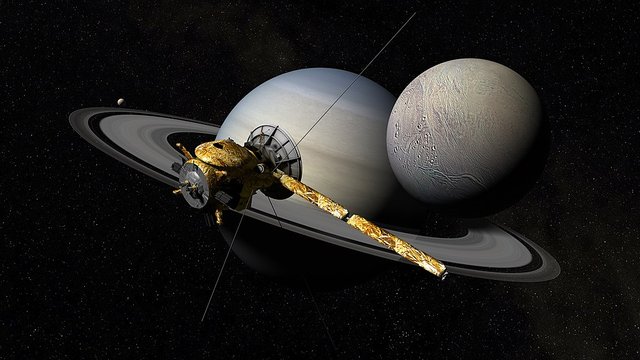
By Kevin Gill from Los Angeles, CA, United States link [CC BY-SA 2.0 license]
Enceladus was discovered by William Herschel in 1789. The largest then telescope with a diameter of 1.2 meters was used to discover. By the time the first cosmic probes were dispatched there, Enceladus was only a small star-like point in the sky for scientists. This satellite circles Saturn in nearly 33 hours and its one hemisphere always faces the planet. So it's like our Earth Moon. The diameter of the Enceladusa orbit is 476 000 kilometers. This satellite is in the orbital resonance with the moon Dione in a ratio of 2: 1 (Dione circulates Saturn every 66 hours). Therefore, as a result of the gravitational forces of the larger satellite Dione and Saturn itself, on the Enceladus tidal forces arise, which are the main cause of its high geological activity. This causes the ice particles to be ejected into space by means of geysers located at the South Pole of the Satelite. This was the reason for the creation of the Saturn ring named E, running along the orbit of Enceladus. This is the first outer ring of this planet.
Enceladus, Earth & Moon size comparison
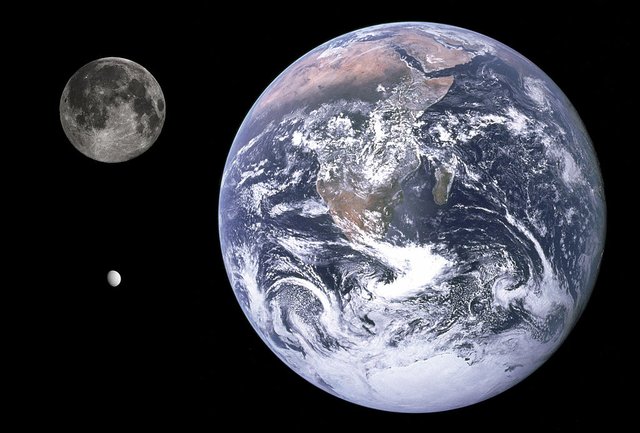
Apollo 17 Picture of the Whole Earth: By NASA, Telescopic Image of the Full Moon: By Gregory H. Revera, Image of Enceladus: By NASA/JPL-Caltech/Space Science Institute link [Public domain images and CC BY-SA 3.0 license for moon image]
Above, in comparison with the Earth and our Moon, we can see that Enceladus is a tiny ice globe. This satellite isn't the perfect sphere. Its dimensions are around 513 at 496 kilometers. The average density of this moon is about 1.6 kg / dm3. This confirms its ice structure, but it contains much more rocks than other known to us ice moons of Saturn. Its internal structure is shrouded in mystery. Scientists believe that under the crust, made of ice, there is a deep ocean of water. Sentences are, however, slightly divided. Some say that it is only located on the south pole of the satellite, while others talk about a deep ocean of 30 to 60 kilometers that fills the entire planet under its shell. Enceladus is one of four (the others are: Earth, Io and Triton) objects in the Solar System, where volcanic processes have been found. Below is a diagram of the likely construction of Enceladus.
Enceladus: Possible Hydrothermal Activity (Artist's Concept)
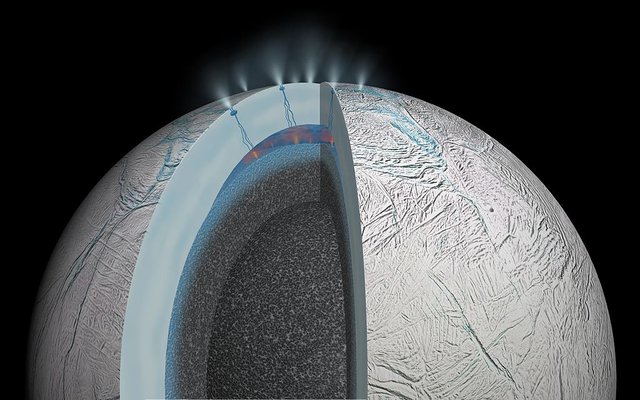
By NASA/JPL-Caltech link [Public domain]
Geysers on Enceladus occur mainly in the vicinity of the south pole, where jets composed mainly of ice, methane and propane particles are fired into space at a speed of about 2000 km/h. They fly up to several hundred kilometers to the height! In addition to the E ring, they also create the delicate atmosphere of Enceladus, the highest density of which is observed near the south pole. This atmosphere consists of water vapor (91%), nitrogen (4%), carbon dioxide (3.2%) and methane (1.7%). However, it is very rare. A small percentage of the geyser eruption components are released into Saturn, leaving traces of water vapor in its clouds. The active Enceladus geysers are shown below. They shoot about 200 kilograms of ice per second into space. Part of this matter falls on the surface of the satellite in a form reminiscent of snowfall.
Enceladus Geysers June 2009
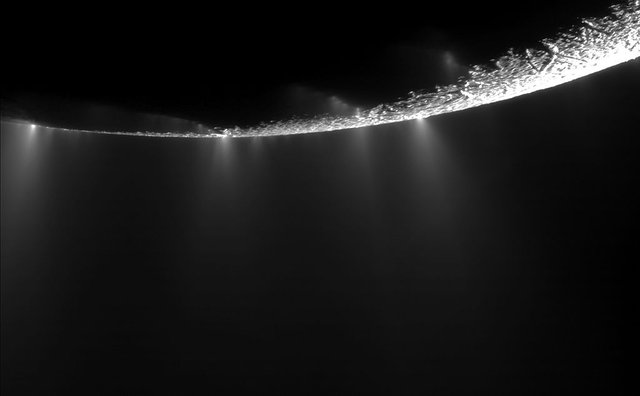
By NASA/JPL/SSI link [Public domain]
The surface of the satellite has a diverse nature. There are areas with a large number of impact craters, but there is no lack of flat, flat terrains of a rather young age. The most interesting elements of the surface are long trenches similar to the ocean ones on Earth. They are called tiger stripes and often their length reaches over 200 kilometers. The largest are wide at around 5 km and deep at km. There is a noticeable difference between the southern and northern hemispheres. On the more active, southern there are many more ridges than in the quiet northern hemisphere, where there are more craters. The largest ones are several dozen kilometers in diameter. Because the bright surface of Enceladus reflects 99% of the energy from the Sun, it is a cold place. Despite volcanic activity, the average temperature here is around -200 degrees Celsius.
Combined pictures of Enceladus in one mosaic
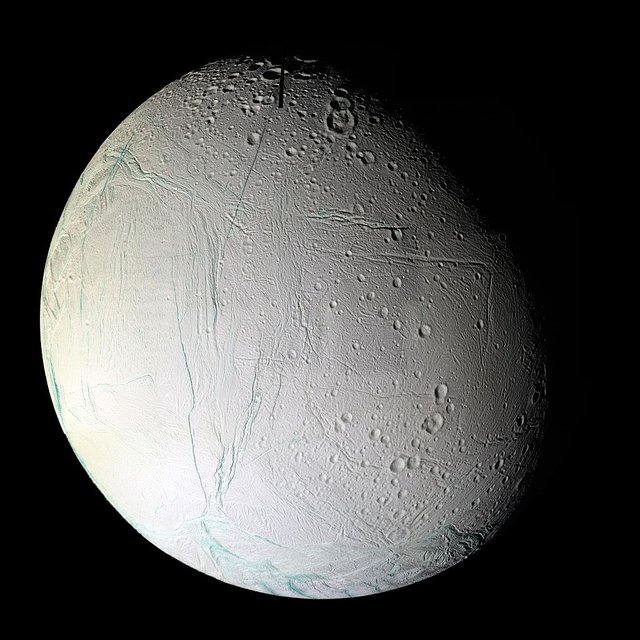
By NASA link [Public domain]
Enceladus was the first to visit the Voyager spacecraft, which reached its vicinity in the beginning of the 1980s. Especially the Voyager 2 probe, which brought the satellite much closer to the satellite, yielding a lot of data for those times. The revolution was the Cassini spacecraft, whose probe flew many times close to Enceladus. Often the distance was less than 50 kilometers. The probe is constantly collecting data on Saturn's moons. Cassini flew the last time over Enceladus in December 2015. Today there are many missions in the plans that will allow you to get to know Enceladus better. It is beyond Titan, the second noteworthy satellite of Saturn. Perhaps we will see a landing on its surface, and perhaps even a mission that will reach the ocean of water in order to search for traces of life on Enceladus.
The south polar region of Enceladus
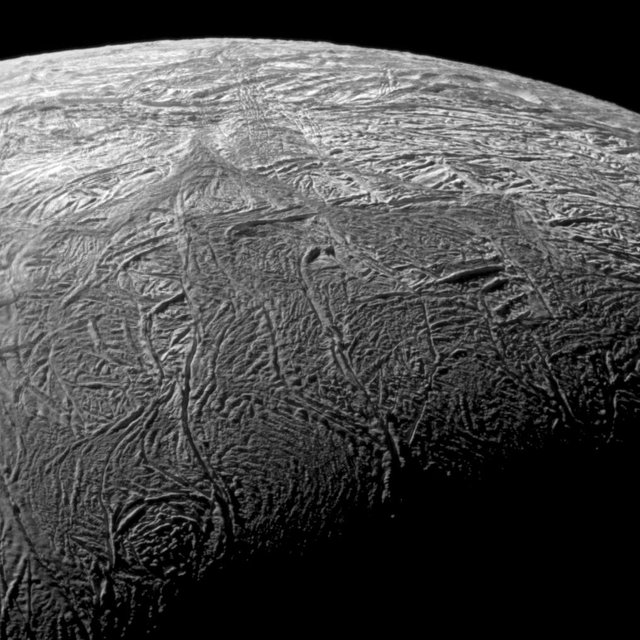
By NASA/JPL/Space Science Institute link [Public domain]
Greetings to lovers of Astronomy!
References:

This post has been voted on by the steemstem curation team and voting trail.
There is more to SteemSTEM than just writing posts, check here for some more tips on being a community member. You can also join our discord here to get to know the rest of the community!
Hi @astromaniac!
Your post was upvoted by utopian.io in cooperation with steemstem - supporting knowledge, innovation and technological advancement on the Steem Blockchain.
Contribute to Open Source with utopian.io
Learn how to contribute on our website and join the new open source economy.
Want to chat? Join the Utopian Community on Discord https://discord.gg/h52nFrV